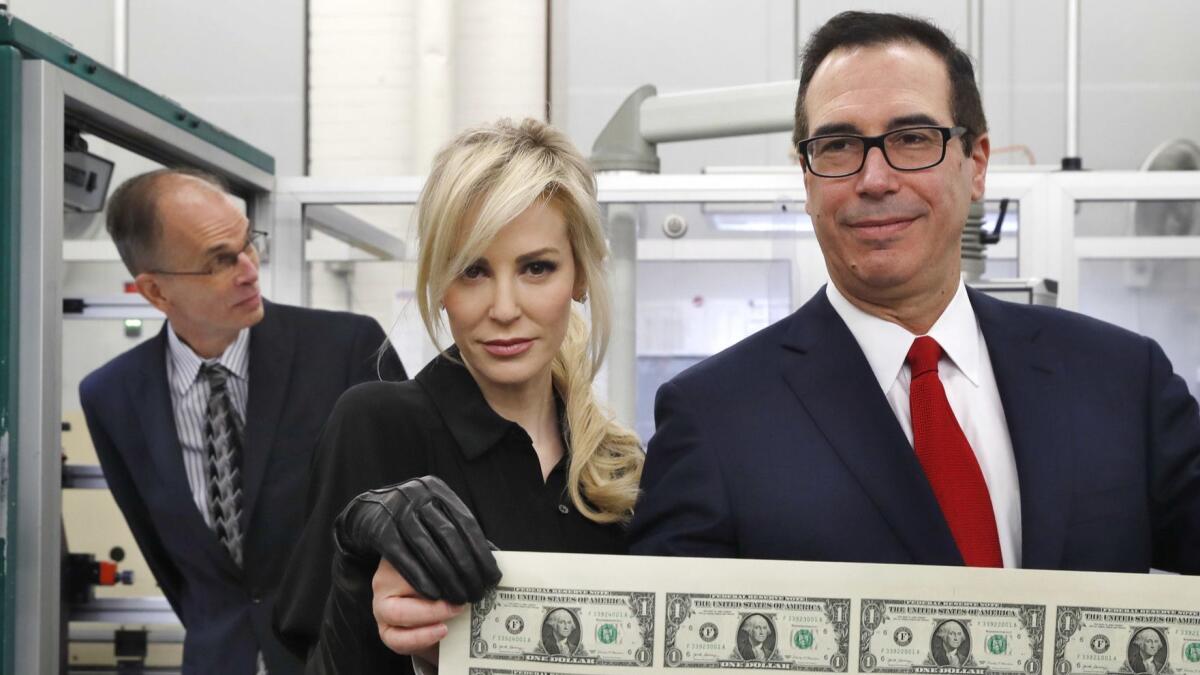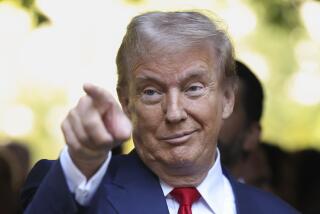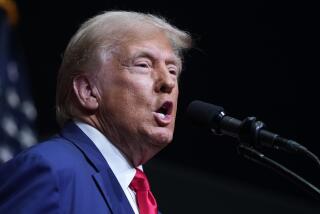Column: Trump’s economic failure: Why his quest for more than 3% growth is falling short

Every so often during 2018, President Trump’s sycophants would point to the quarterly figures on gross domestic product and crow about how his brilliant economic leadership had fulfilled his promise of growth of 3.5% or more.
On Thursday, the government released its preliminary GDP figure for 2018. It’s not 3.5% or more. It’s 2.9%. That may not seem like much of a shortfall, but it points to the difficulty Trump has faced in reaching his promised goal on a sustained basis.
Moreover, the 2018 growth figure is beginning to look like a high point for his presidency. Growth for the fourth quarter came in at an annualized 2.6%, a sharp retreat from the 3.4% in the third quarter. (The figures are inflation-adjusted.)
It’s proper to observe that the figures released Thursday by the Bureau of Economic Analysis are subject to two revisions, starting on March 28. So it’s possible that when the final numbers are in, the economy will be seen to have eked out a growth rate just over 3% for 2018. But it’s unlikely to come close to the soaring growth of 3.5% a year, even 4%, that Trump promised during his presidential campaign.
Wow is this economy sizzling.
— Stephen Moore, Heritage Foundation, after two quarters of strong growth in mid-2018
On a quarterly basis, the economy grew at an annualized rate of 4.2% in the second quarter and 3.4% in the third. But a further slowdown looms in the future.
Economist Ian Shepherdson of Pantheon Economics termed the figures “not bad, but not the end of the softening, either.” He says his charts indicate that “growth has now peaked,” with intensifying headwinds facing the economy in the current first quarter of 2019.
Back in May 2017, we labeled the prospect of sustained real annual growth of more than 3% to be a “pipe dream.” We stand by that judgment.
Trump’s followers were quick to seize on glimmers during 2018 that Trumponomics, such as they are, were turbocharging the economy. In October, after the second consecutive quarter of annualized gains higher than 3%, Stephen Moore of the conservative Heritage Foundation boasted about the “Trump moon bounce in the financial markets and the real economy.” He told me by email, “Yes, it is hazardous to read too much into 6 months of data, but wow is this economy sizzling.”
Let’s unpack why Trump has found it so hard to reach his goal in the longer term.
As we wrote in 2017, gross domestic product growth comes from two main sources: growth in the labor force and growth in productivity.
Trump maintained that he could improve on the first because — so he claimed — President Obama’s economic policies threw millions of Americans out of work.
But unemployment statistics suggest instead that there isn’t much slack in the workforce. At 4.4%, the unemployment rate is at about the point economists judge to be full employment. It’s true that the labor participation rate — the share of working-age persons with jobs — has risen during the Trump administration, but only from 62.9% when he became president to 63.2% in January. The aging of the U.S. population leaves little hope of substantial further gains.
The most recent increases in the workforce occurred in the 1970s through the 1990s, with the entry of baby boomers and women. But the baby boomers of both sexes are retiring now. According to the Pew Research Center, unless immigration takes up the slack by providing 18 million more workers, the U.S. workforce will continue to shrink at least through 2035.
The second major factor, productivity, defined as real output per hour of labor, has been mired in a slump for more than a decade, averaging 1.1% growth per year from 2008 through 2016, and reaching 1.3% in the fourth quarter of 2018. That’s meager compared to the postwar average of 2.3%; the last high point was reached in 2001 through 2007, when growth averaged 2.7% a year. Economists think the rate is unlikely to pick up to the degree necessary to jolt economic growth above 3% for the long term.
Then there’s the Trump effect. Some of Trump’s policies work against the trends needed to spur growth, notably his hostility to immigration, which is needed to shore up the aging U.S. workforce.
Deregulation, as we observed in 2017, doesn’t spur economic growth as its fans promise, because it tends to create costs or shift them from one sector to another — the consequences of dirty air and water and the tax on the economy imposed by lack of health insurance are real costs.
The tax cuts enacted by Republicans in Congress and signed by Trump in December 2017 gave the economy a jolt, presumably accounting for at least some of the spurt in the second and third quarters. But it was a notably unproductive jolt, akin to a swig of a supercaffeinated cola, and it has already shown signs of ebbing.
The tax cuts went chiefly to the wealthy and corporations. There are no signs that the latter put them to productive use, as opposed to passing them through to shareholders in the form of dividends and stock buybacks. The wealthy don’t pump increases in their disposable income into the economy at anywhere near the same rate as the middle and workingclass.
The GOP hope was that the increase that ordinary taxpayers saw in their take-home pay as a result of the cuts would translate into more consumer spending. That seemed to happen, for a time, but the trend has been evanescent. The reaction of taxpayers to the lower refunds they’re getting this tax season — and some have moved from refunds to tax bills — may be to pare back spending this year, since many families habitually put their refund checks toward big-ticket purchases.
A Trump administration genuinely focused on spurring higher growth throughout the economy would do many things differently. Instead of funneling government resources toward the wealthy via a tax cut they didn’t need, it would have spent billions on infrastructure construction and repair, which would put millions of Americans to work and remove the economic drag created by potholed roads and crumbling bridges.
It would have moved heaven and Earth to expand and extend the health coverage brought to 20 million Americans via the Affordable Care Act, instead of taking every possible step to shrink the population of insured Americans and making decent coverage cheaper.
But that presupposes that the Trump administration actually has an economic policy. Few indications exist that it does, rather than a collection of initiatives disconnected from one another and from economic reality.
Having an ill-considered economic policy is bad enough; having none at all is tragic. From Trump’s standpoint, it’s even worse, for it turns his campaign pledge into just another broken promise.
Keep up to date with Michael Hiltzik. Follow @hiltzikm on Twitter, see his Facebook page, or email michael.hiltzik@latimes.com.
Return to Michael Hiltzik’s blog.
More to Read
Inside the business of entertainment
The Wide Shot brings you news, analysis and insights on everything from streaming wars to production — and what it all means for the future.
You may occasionally receive promotional content from the Los Angeles Times.











